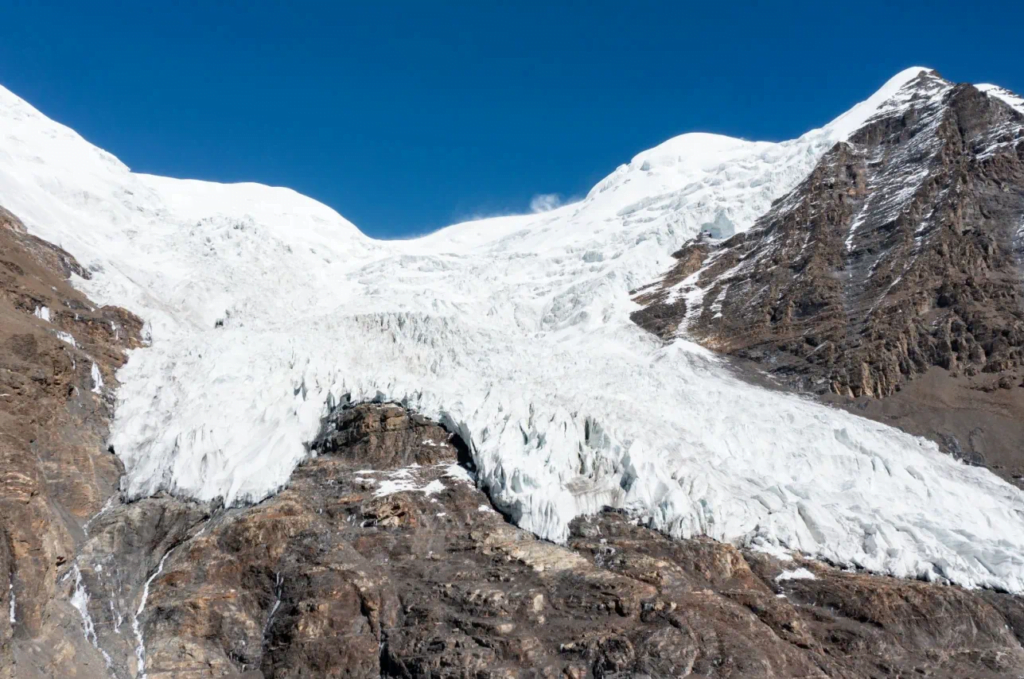Nojin Khangsang: An Iconic Tibetan Mountain
Discover the majestic Nojin Khangsang (Nyenchen Khangsar), a revered peak in the heart of Tibet. This mountain, known for its spiritual significance. It translates in Tibetan as the abode of the “Medicine Fork God on the Noble Snow Mountain.” It is famed as the residence of one of Tibetan Buddhism’s four great mountain gods, the Western Nojin Kangwa Sangpo Mountain God, and is also referred to as “Nor Jin Kangsang La,” “Nyenchen Kangsar,”
Majestic Heights and Spiritual Connection
Positioned between Nagarze and Gyantse, Nojin Khangsang soars to an impressive 7,191 meters, making it one of the 44 peaks open to climbers in Tibet and a notable national tourism resource. The area is home to more than ten peaks that exceed 6,000 meters. Nojin Khangsang is one of the central four great snow mountains of Tibet. The peak boasts a year-round blanket of snow, glaciers, and occasional avalanches. The Chinese Tibet Mountaineering Team first successfully ascended the peak on April 28, 1986. They took a route along the southwest ridge from the south slope.

The Karola Glacier: A Natural Wonder
At the southern base of Nojin Khangsang lies the breathtaking Karola Glacier. This natural marvel stretches up to 300 meters from the roadside, presenting a dramatic, waterfall-like appearance that abruptly stops mid-slope. The lower ice tongue of the glacier forms a striking array of jagged ice towers, seemingly poised to cascade onto the road below.
Cultural Resonance in Cinema
The Karola Glacier, spanning 9.4 square kilometres, gained wider recognition through its feature in the film “Red River Valley. (红河谷)” This cinematic portrayal highlighted a British scientific expedition in the Himalayas and a catastrophic avalanche triggered by a rash action, engulfing both the caravan and the expedition team.
The Origin of the Nyangchu River
The glacier’s terminus gives rise to numerous streams that wind down the mountain’s steep ridges. These waters eventually converge at the base of the mountain, forming the meandering course of the Nyangchu River, a significant water source in the region.
Travel Highlights and Tips for Nojin Khangsang
The Mountain God Noji Kangwa Sangpo
Noji Kangwa Sangpo, revered as the chief land god of Western Tibet and companion of God Vaisravana, manifests in six distinct forms, each uniquely adorned and holding sacred symbols.
Visiting Nojin Khangsang
- Mountaineering Base Camp: The base camp is located at the end of the Karola Glacier, about 187 kilometres from Lhasa. Optimal climbing seasons are from April to May and September to October.
- Glacial Features: The Karola Glacier is a stunning hanging glacier formed from the southward movement of the Nojin Khangsang glacier. It features eastern and western ice tongues with remarkable dimensions and elevations, offering a unique glacial landscape.
- Ease of Access and Viewing Points: Conveniently situated at the crossroads of Nagarze and Gyantse counties, Nojin Khangsang offers easy road access. The glacier’s end, equipped with a parking area, allows visitors to closely observe and photograph the glacier’s imposing presence.
- Photography Opportunities: Ideal photography times are within two hours after sunrise and three hours before sunset. Visitors can also capture memorable photos with the local yaks and enjoy the scenic beauty marked with stupa, prayer flags, and commemorative signage.
Journey to Nojin Khangsang for an unparalleled experience of Tibet’s natural grandeur, cultural depth, and spiritual essence. This destination promises awe-inspiring views, a rich tapestry of history, and an unforgettable adventure for every traveller seeking to connect with the heart of Tibetan landscapes and spirituality.




















